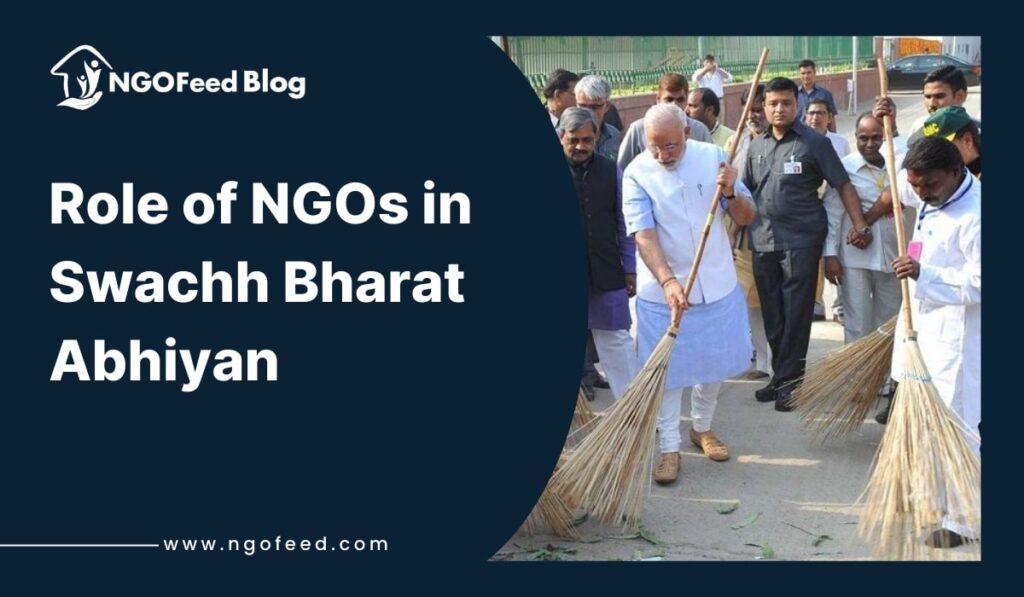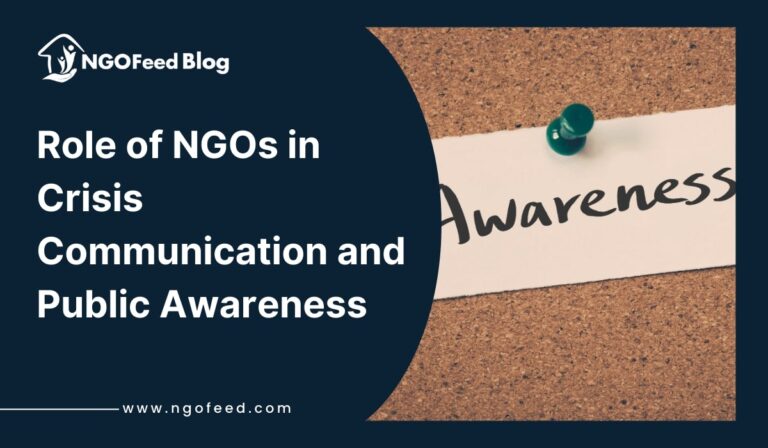Role of NGOs in Swachh Bharat Abhiyan: On October 2nd, 2014 the Swachh Bharat Abhiyan (Clean India Mission) established itself as one of India’s largest programs to combat sanitation and cleanliness issues. The Government of India leads this mission that strives to create a sanitation system where India remains both ODF and solid waste management capable while promoting behavioral change through enhanced infrastructure. The government’s vital role in policy deployment and fund distribution has been reinforced by NGO associations which direct community efforts and foster awareness while sustaining local progress.
The work of NGOs contributes both the practical knowledge they gain from working in communities and cost-efficient solutions that address local requirements. The organizations participate in rural hygiene workshop delivery build toilets in communities lacking access and execute cleanliness operations in urban slum areas. non-profit organizations in India have developed a people-driven cleanliness movement through their partnerships with local authorities schools and self-help groups as well as other stakeholder organizations.
Behavior change communication initiatives developed by NGOs serve as a central element of the campaign through which they utilize street plays digital media and radio jingles combined with poster campaigns to educate people about sanitation importance. These organizations have established a key link between what exists in policies and what occurs in practice to guarantee mission goals are achieved in every corner.
Also Read: Role of NGOs in Advocacy
This paper examines the diverse NGO efforts that advance and enhance the Swachh Bharat Abhiyan by explaining important initiatives with their accomplishments and obstacles while emphasizing their essential contribution toward building a clean healthier nation.
Table of Contents
Role of NGOs in Swachh Bharat Abhiyan
Various actions by NGOs support Swachh Bharat Abhiyan’s objectives through targeted work to build awareness while developing infrastructure and engaging the community. Their initiatives successfully extend the government initiatives by delivering sustainable mission implementation at the local level.
Also Read: Role of Cryptocurrency in Nonprofit Donations
1. Awareness Campaigns and Behavioral Change
The main effect of NGOs comes from their effort to change behavioral patterns through Information Education Communication (IEC) initiatives. They have conducted:
- Door-to-door awareness drives
- Sessions such as street play community meetings and clean-up events are organized.
- NGOs conduct public information drives educating people about handwashing together with hygiene practices and sanitation operations.
- The programs have broken through traditional beliefs about toilet usage specifically in rural communities thereby stimulating community members toward better hygiene practices.
2. Infrastructure Development
Numerous non-government organizations have focused their work on constructing and enhancing sanitation facilities throughout inadequate marginal areas. Their involvement includes:
Also Read: Transparency in Nonprofit Operations
- Construction of household and community toilets
- The installation of handwashing stations serves as an addition to school facilities throughout different educational facilities.
- As part of an eco-friendly waste approach, NGOs work to promote composting along with bio-toilet systems.
- These organizations ally with government institutions CSR financial support and international charitable donations to generate project funding.
3. Community Mobilization and Participation
Local communities and women and children have successfully participated in sanitation programs through the work of NGOs. Their program implements local committees to oversee sanitation together with volunteer training to establish community-based responsibility. The local networks of these organizations enable them to achieve the following objectives:
Also Read: Role of ICARDA in India
- Facilitate community-led total sanitation (CLTS)
- Cleanliness ambassadors should include both self-help groups and schoolchildren in their programs
- Organizations need to extend their efforts towards involving every community member regardless of their social status.
The various contributions of organizations strengthening Swachh Bharat Abhiyan have developed it into an active national movement from an initial policy strategy.
Role of NGOs in Swachh Bharat Abhiyan – Case Studies and Success Stories
Organizations in India have launched creative community-based sanitation programs that positively affect the outcomes of Swachh Bharat Abhiyan. Community-driven endeavors backed by collaboration and creativity at the local level result in genuine transformative changes.
1. Sulabh International – A Nationwide Sanitation Pioneer
Sulabh International stands as a well-known NGO in the sanitation sector by building over 1.5 million household toilets and establishing more than 9,000 public toilets throughout India. The widely accepted two-pit pour-flush toilet design from this enterprise brings affordability along with environmental friendliness to the table. Sulabh uses its resources to end manual scavenging by delivering alternative work opportunities alongside basic sanitation training to multiple communities.
Also Read: Role of NGOs in Sustainable Development
2. Gramalaya – Transforming Rural Tamil Nadu
As a Tamil Nadu-based organization Gramalaya played a key role in making thousands of villages achieve open defecation-free (ODF) status. The organization helps women gain empowerment by establishing self-help groups that combine microfinance to construct toilets. Gramalaya aided Thandavampatti to become a benchmark for complete sanitation while helping South India achieve numerous similar commitments.
3. Feedback Foundation – Community-Led Total Sanitation in Uttar Pradesh
Through its partnerships with government bodies The Feedback Foundation executes Community-Led Total Sanitation (CLTS) programs across Uttar Pradesh and Bihar and Haryana. By bringing people together the organization has enabled villages to declare two hundred sustainable ODF declarations through active community participation.
Also Read: Role Of NGOs in Psychological Support After Tragedies
4. FINISH Society utilizes Rajasthan as its base for providing Sanitation services and conducting Financial Inclusion projects.
FINISH Society merges sanitation development programs with monetary inclusion initiatives as part of its operations. The NGO collaborated with microfinance institutions in Rajasthan to enable families to finance toilet construction through available funding options. Through their training of masons and educational programs about hygiene, the organization achieved better sanitation coverage in poverty-stricken areas of Rajasthan.
Non-government organizations demonstrate their essential role in making the Swachh Bharat vision accomplished through sustainable measurable results. Their localized, participatory, and sustainable approaches continue to inspire future action across the country.
Challenges Faced by NGOs in Swachh Bharat Abhiyan
Non-governmental organizations working on Swachh Bharat Abhiyan programs encounter several important obstacles that make it difficult to maintain consistent operational performance and qualitative sustainability of sanitation projects. The problems NGOs face affect financial systems while also impacting operational matters and cultural practices.
Also Read: Leveraging (X) Twitter Trends for Nonprofits
1. Funding Constraints
Non-Governmental Organizations commonly experience insufficient money that arrives erratically. Financial support from CSR partnerships and government grants is difficult to obtain because obtaining and sustaining these funds requires extensive work with complex bureaucratic processes. The restricted budgets limit their projects to operate in only small zones where they cannot create significant change, especially in underdeveloped rural spaces.
2. Bureaucratic Hurdles and Coordination Issues
The process of teaming up with local governments panchayats and public health departments requires organizations to deal with complicated administrative barriers. Project implementation pauses because different government departments need excessive time to approve projects and they fail to show clear direction about who should do what along with inadequate coordination between teams.
3. Resistance to Behavioral Change
Cultural traditions related to sanitation such as open defecation transform only through time. The resistance of communities who reject the immediate need for toilets with additional hygiene practices as well as waste segregation practices is common among areas with low literacy and public awareness.
Also Read: How NGOs Can Leverage Data Analytics?
4. Lack of Skilled Manpower and Technical Expertise
Apart from trained personnel masons, health educators, and waste management specialists are needed to successfully implement sanitation projects. The lack of professional experts in NGOs leads to substandard quality management of their operations while shortening their initiative sustainability.
5. Monitoring and Impact Evaluation Challenges
The continuation of cleanliness efforts depends on permanent evaluation work combined with maintained motivation for desired behavior. NGO projects experience poor sustainability because these organizations lack the proper infrastructure for strategic impact assessment programs to monitor their initiatives effectively. This leads to goal abandonment and weakened progress in specific areas.
The challenges do not deter NGOs from continuing their innovative work which demonstrates strong dedication toward sustaining a clean healthy India.
Also Read: Role of NGOs in Conservation and Biodiversity Protection
Conclusion and the Way Forward
The Swachh Bharat Abhiyan has been a path-breaking campaign in India’s progress towards better sanitation and hygiene, and NGOs have been the key player in making this dream a reality on the ground. Ranging from community mobilization and building toilets to behavioral change promotion and tracking progress, NGOs have been the backbone of most successful missions under the campaign.
Their capacity to engage with communities, listen to local issues, and apply locally tailored solutions has been a huge asset in places where government initiatives by themselves might be insufficient. By bridging key gaps in awareness, outreach, and sustainability, NGOs have made Swachh Bharat Abhiyan a people’s movement rather than a policy.
Also Read: Role of NGOs in Environmental Protection
But to maintain and expand this effect, more effective collaboration between NGOs and government institutions is needed. The future direction includes:
- Institutionalized partnership: Having platforms for ongoing dialogue and cooperation between NGOs and local governments can result in better-coordinated and effective implementation.
- Simplified mechanisms for funding: Simplifying CSR and government grants will allow NGOs to access adequate and timely funds.
- Capacity building: Collective training programs can assist in building the technical capacity and leadership abilities of NGO staff and local community volunteers.
- Technology integration: Harnessing digital resources for monitoring, awareness, and transparency can be used to increase accountability and impact measurement.
Also Read: Role of NGOs in Street Children
As India progresses from target achievement to sustaining it, NGOs will be crucial partners in the sustenance of long-term cleanliness, hygiene, and public health. They are important to be enabled to strengthen their role in creating a genuine Swachh and sustainable Bharat.










